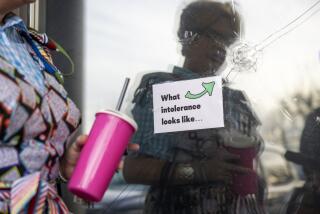Afghanistan killings raise questions about alliance with U.S.
The clusters of bodies heaped in a rural Kandahar hamlet have given rise to the inevitable question: Are U.S.-Afghan relations now too tainted for the nations to move ahead as allies in this war?
On Sunday, a lone American serviceman slipped away from his base in southern Afghanistan before dawn and went on a methodical house-to-house shooting spree in a nearby scatter of Afghan homes, killing 16 people as they slept, nearly all of them women and children, according to Afghan officials who visited the scene.
The NATO force said the assailant was in military custody, having surrendered upon his return to base, and acknowledged that he had inflicted an unspecified number of casualties during the shooting spree that began about 3 a.m. in the Panjwayi district of Kandahar province.
A senior U.S. military officer in Washington described the shooter as an enlisted soldier but did not say what unit he was assigned to. The major U.S. Army unit in the area, according to the military, is the 1st Stryker Brigade of the 25th Infantry Division. But there are multiple other smaller units.
President Obama, in a statement, expressed “condolences to the families and loved ones of those who lost their lives, and to the people of Afghanistan, who have endured too much violence and suffering.
“This incident is tragic and shocking, and does not represent the exceptional character of our military and the respect that the United States has for the people of Afghanistan.”
Other U.S. officials called for calm and warned of potential reprisals against Americans in Afghanistan. Angry villagers in Panwayi carried some of the corpses to the U.S. base from which the assailant had come, and military installations across the country, together with Western embassies and foreign organizations, braced for the possibility of mass protests.
The Taliban movement — seizing on undreamed-of fortune — referred to the killings as an “act of genocide.” Afghan President Hamid Karzai called the shootings “intentional killings” and demanded an explanation from the American administration.
The incident, by far the worst known atrocity of the 10-year war to be deliberately carried out by a single Western soldier, represents a stunning new setback to U.S.-Afghan relations, most recently shaken by last month’s burning of copies of the Muslim holy book at a U.S. military base north of Kabul.
Anti-U.S. sentiment flared into deadly riots after the Koran burning at Bagram airfield came to light. American officials have said the action was a mistake and offered profuse apologies, but some Afghans, including lawmakers and senior clerics, nonetheless called for harsh punishment of those involved.
Sunday’s shootings took place outside Kandahar city, in a pair of adjoining villages, Alkozai and Balandi, residents said.
Speaking on condition of anonymity, military officials said it was believed that the assailant had suffered a mental breakdown. But among Afghans, psychiatric disorders are rarely spoken of, and mental illness is not generally considered a mitigating factor in a violent crime.
Already, there were calls from Afghans for the assailant to stand trial in this country, but the American military has its own system of trial, conviction and punishment. Late last year, four soldiers from a Washington state-based Stryker brigade were sentenced to prison for the killing of three unarmed men for sport during patrols in Kandahar province, the most gruesome previously known attacks on civilians since the U.S.-led invasion of Afghanistan in 2001.
In Panjwayi, reaction to the shooting spree ranged from shock to rage. Wali Mohammad, who said 11 of the dead were members of his uncle’s family, called it an act of wanton cruelty.
“Americans have never respected our culture, and we will never be secure while Americans are here,” he said.
In the snow-shrouded capital, Kabul, even people who are generally supportive of the Western military presence were shocked to the point of grasping for words.
“I didn’t believe it at first,” said businessman Fayez Ali. “I thought it was some Taliban fairy tale. But it is … this is real. And maybe this is our true reality.”
The North Atlantic Treaty Organization force issued a terse statement confirming casualties and promising a full investigation by U.S. and Afghan authorities. The commander of the U.S.-led coalition, Gen. John Allen, who was visiting the United States, issued a statement of “profound regret,” promising a rapid and thorough investigation.
“This deeply appalling incident in no way represents the values of … coalition troops or the abiding respect we feel for the Afghan people,” he said.
In the hours after the shooting rampage, casualty counts varied widely. By late afternoon, however, an official provincial delegation had arrived at the scene. Haji Agha Lalai Dastgeeri, a member of that team, said the official tally was 16 dead. “I saw the dead bodies and visited the victims’ families,” he said soberly.
According to the Afghan presidential palace, nine of the victims were children and three were women.
The attacker’s motive was unknown, but relations between the U.S. military and ordinary Afghans have been highly fraught since February’s Koran-burning riots, which exacerbated long-standing tensions over civilian casualties and night raids led by U.S. special forces.
During more than a week of nationwide protests over the burning of the holy books that left at least 30 people dead, six U.S. service members were shot and killed by Afghan soldiers or, in the case of two of them, a worker at Afghanistan’s Interior Ministry. Two of the American troops who were killed were deployed in Kandahar province.
Kandahar, which is President Karzai’s home province, is also the birthplace and spiritual home of the Taliban. Panjwayi district was the scene of heavy fighting two years ago as U.S. forces made a major push to dislodge the insurgents, and parts of the district remain volatile.
The episode is certain to complicate U.S. dealings with Karzai, who has been resistant to American plans to try to inaugurate peace talks with the Taliban movement in the Persian Gulf state of Qatar, fearing being cut out of important decision-making. The shooting comes days after an agreement to hand suspected insurgents in American custody over to control of Afghan officials — a process that is expected to take months. Karzai had demanded an immediate hand-over of the main U.S. detention center.
There are about 90,000 U.S. troops in Afghanistan, a number that is to fall to about 68,000 this year. At its peak, the American force numbered more than 100,000.
Times staff writer David S. Cloud in Washington and special correspondent Aimal Yaqubi in Kabul and a special correspondent in Kandahar contributed to this report.
More to Read
Start your day right
Sign up for Essential California for news, features and recommendations from the L.A. Times and beyond in your inbox six days a week.
You may occasionally receive promotional content from the Los Angeles Times.






